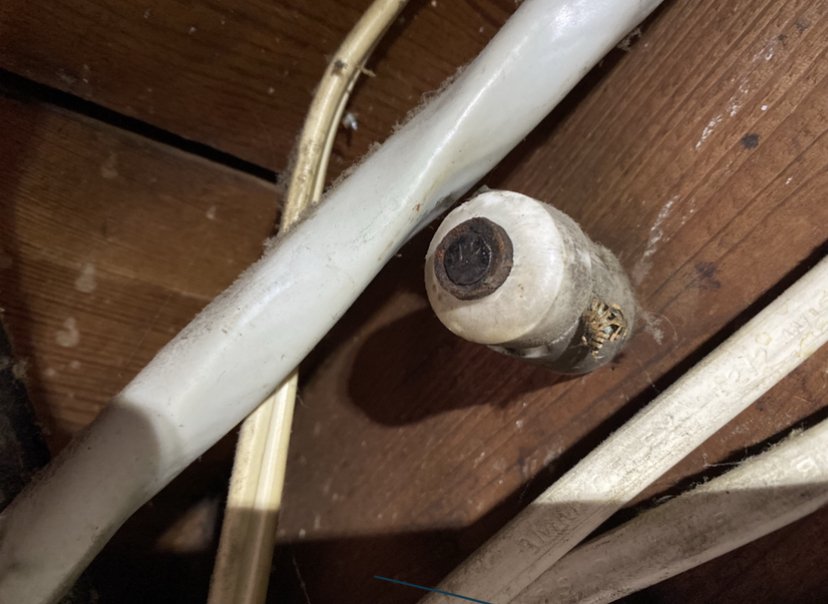As electricians in an historic town, we’ve seen just about every iteration of electrical wiring that has existed from the beginning of bringing electricity in the homes. So many of the older wiring system still exist in many homes today and for the most part, they’re fine, so long as you don’t handle or manipulate them. This includes adding new receptacles or fixtures to old wiring or any kind of troubleshooting that would require the movement of an existing historic wire. Because the insulation on these historic conductors is so old, moving or manipulating the conductors can break, crack or fray the insulation, leaving you with exposed portions of live electrical wires. This is why we, as contractors, will only take on some historic wiring projects with the caveat that the old system be replaced with new.
This article is designed to help our community of clients better understand what sort of wiring may exist in their walls and what the dangers, if any, might be. When considering what type of conductors may be power in your historic home, the first question you would want to ask yourself is how old is my house? The reason this is important is because, like everything, residential electrical wiring has evolved over time. The earliest forms of electrical wiring in homes can be traced back to the late 1800s. During this time very few people actually had electricity in their homes so you don’t see a lot of residential wiring outside of cities from the 1800s. The main form of electrical wiring from the late 1800s to around the 1930s was called knob and tube wiring.
Knob and tube wiring is prevalent in many of the homes in our beautiful, historic hometown of Frederick, Maryland and in many cases it is still powering the entirety of the homes in this area. This means that in many cases, no remediation has been performed to update the conductors inside the walls and ceilings of the home since its original installation. Knob and tube wiring gets its name due to the porcelain elements (knobs and tubes) that aid the conductors in moving from point A to point B throughout the home. The porcelain knobs were designed to hold the individual conductor in place as it ran horizontally or vertically along joists or studs. The porcelain tubes were used to add a non-conductive barrier between the conductor and the wooden structure it penetrates. This was the same technology that Thomas Edison used when he wired JP Morgan’s New York City mansion in the 1800s. It’s wild to imagine that it is still in use today.
If you find that you’re home still has active knob and tube wiring powering your lights and outlets, there are a few options for you. The first is to leave the circuits as they are and to install breakers that offer ground fault circuit interruption (GFCI) protection. There are, however setbacks to this approach. The first is, knob and tube wiring was prevalent before the era where individual grounding conductors were installed in every circuit. Nowadays, every electrical cable comes equipped with a hot, a neutral and ground conductor. The ground conductor offers a path for the electrical current to take in the event of a short circuit or ground fault. Without this added protective measure, knob and tube circuits are inherently more dangerous than modern wiring. This means that in the event of a short circuit, a full discharge may not take place and the breaker may not trip. This can lead to heat build up and eventually a fire. It also means that electric shock is more of an issue because the metal boxes used during this era are not bonded to the grounding system, potentially making them live in certain scenarios. This can be dangerous for anyone reaching down to handle the metal box or the device within it. By adding a GFCI breaker at the beginning of a knob and tube circuit, you are effectively offering yourself added protection in the absence of a ground conductor.
The second course of action that can be taken with knob and tube wiring is a complete Remediation of the Circuits still being powered by the historic technology. The downside to this course of action is it invasiveness. In order to get new conductors from point A to point B (for example, from a light switch to a new lighting location) portions of the plaster and lath walls and ceilings will need to be opened. This is a dusty, invasive process and requires quite a bit of patching and painting on the backend. The result, however is a safe home that is up to current electrical codes. In our opinion, there is really no substitute for the peace of mind that comes from knowing that your home can handle whatever electrical upgrades you’d like to perform. One of the major downsides to having older wiring technology in your home is it makes it increasingly difficult to perform renovations. The old systems just can’t handle many of the demands of the newer appliances available.
The next type of historic electrical wiring you may find in your historic home is what we in the industry referred to as BX. BX is an Electrical cable with a metal outer jacket with typically two-three conductors inside. Wow this cable did not originally come with an individual grounding conductor, the metal outer jacket acts as an effective bonding mechanism giving your devices and systems an effective path to ground. If you find that your home is still wired by BX wiring, you are in luck. So long as you don’t manipulate the old conductors, the outer jacket is very protective and keeps the wires inside of it in very good shape (plus the fact that the outer jacket offers an effective ground). While we always suggest remediation of historic wiring eventually, BX wiring is your best case scenario.
Another type of historic wiring that you may come across in an historic home is aluminum wiring. Aluminum wiring is very common in homes that were built in the 1960s and early 70s. This is due to a price increase in copper around that time. Aluminum wiring was approved for 15 and 20 amp circuits in homes around the 1940s but it wasn’t until the price increase of copper that they became more prevalent in homes. If you find that your home has aluminum wiring, there are a couple things you can do. The first is obviously a complete remediation of the aluminum wiring. Aluminum is a softer metal than copper and is not quite as conductive. Aluminum also oxidizes at a higher rate than copper does and it requires that the devices you use are rated for aluminum wire. Because modern electrical devices are designed primarily for copper installations, aluminum wiring can be a big problem. Dissimilar metals, when combine together will oxidize. The result is more resistance in a circuit, often times breaks in the softer metal, which all results in heat build up. In lieu of a complete home rewire, it is acceptable to connect new copper conductors to older aluminum conductors via a method of a wire connector that contains a fluid that prevents oxidization. If you do have aluminum wiring throughout your home, we recommend one of these two methods.
The fourth and final wiring methods we will mention here is what we in the industry referred to as “rag wire.” Rag wire was a post knob and tube wiring method (around the same time as BX) that included 2, sometimes 3 conductors inside of a pre-fab jacket consisting of an early rubber/cloth compound. This style of wiring predates our current electrical cables and set the tone for what future cables will look like. The real downside to the style of wiring is that the earliest models of it did not contain an individual grounding conductor. Because they also do not have a metal outer jacket to offer an effective bond to the grounding system, there is no path to ground in the event of a short circuit or a ground fault. In these instances, we recommend a similar solution to the knob and tube situation, which is to GFCI protect the rag wire circuit at the electrical panel with a GFCI protected breaker.
Many of us purchased historic homes because of their inherent beauty, unbelievable craftsmanship and tank-like construction. One of the downsides to buying one of these beautiful old houses is that you may need to remediate the electrical wiring inside. We hope that this article help you better understand what sort of wiring you may have powering the lights in devices inside your historic home. If you find that your home has one of these historic wiring methods, please contact a qualified local electrician that has experience in this realm.




